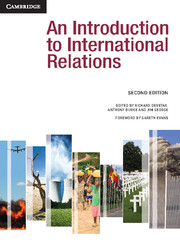Book contents
- Frontmatter
- Contents
- Tables, Figures and Boxes
- Contributors
- Preface and acknowledgements
- An Introduction to International Relations: The origins and changing agendas of a discipline
- 1 Theories of International Relations
- 1 International Relations Theory in an Age of Critical Diversity
- 2 Realism
- 3 Liberalism
- 4 Marxism and Critical Theory
- 5 Feminism
- 6 Postmodernism
- 7 Constructivism
- 8 Theories of Global Justice
- 2 The Traditional Agenda
- 3 The New Agenda
- Glossary of Terms
- Bibliography
- Index
- References
2 - Realism
from 1 - Theories of International Relations
- Frontmatter
- Contents
- Tables, Figures and Boxes
- Contributors
- Preface and acknowledgements
- An Introduction to International Relations: The origins and changing agendas of a discipline
- 1 Theories of International Relations
- 1 International Relations Theory in an Age of Critical Diversity
- 2 Realism
- 3 Liberalism
- 4 Marxism and Critical Theory
- 5 Feminism
- 6 Postmodernism
- 7 Constructivism
- 8 Theories of Global Justice
- 2 The Traditional Agenda
- 3 The New Agenda
- Glossary of Terms
- Bibliography
- Index
- References
Summary
Introduction
This chapter reflects on the tradition of political thought known as realism. Its main purpose is to identify who realists are, and to explain what realism is in the study of international relations. The first part of the chapter introduces students to some important thinkers, both ancient and modern, ascribed to the realist tradition of thought. It also identifies two broad strands of realist thought: ‘classical’ and ‘structural’ or ‘neorealist’. The second part investigates attempts to conceive realism as a unified theory and practice of international relations. It highlights realism’s central concepts of the state and anarchy before reflecting on realism’s normative dimension.
Realism has historically been the dominant theory of International Relations and a point of reference for alternative theories, even if only critically. It aspires to be suprahistorical, explaining in all epochs the fundamental features of international politics: first and foremost, conflict and war. Emerging in the 1930s, realism’s polemical target was the progressive, reformist optimism connected with liberal internationalists such as American president Woodrow Wilson. Against this optimism, realism comported a more pessimistic outlook which was felt to be necessary in the tragic realm of international politics.
- Type
- Chapter
- Information
- An Introduction to International Relations , pp. 35 - 47Publisher: Cambridge University PressPrint publication year: 2011
References
- 1
- Cited by



